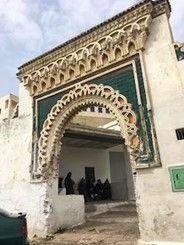Sayyida Al-Hurra: The Story
- nwinmill
- May 18
- 3 min read
Updated: Jun 6

Sayyida Al-Hurra was born to a noble family in Granada, Spain, and fled to North Africa in 1485 when the Spanish Reconquista, led by King Ferdinand and Queen Isabella of Castille and Aragon, involved the expulsion of Moors and Jews from Spain. Granada was the last city of Al-Andalus to fall after the Moors had held Spain for over seven hundred years. Many Hispano-Moors settled in Morocco. Al-Hurra’s father Moulay Ali founded the blue-walled city Chefchaouen, near Morocco’s northern coast and below the Riff Mountains and continued to welcome refugees from Al-Andalus (Ali, 2018).
As a member of the wealthy and respected Banu Rashid family, Sayyida Al-Hurra had a good upbringing in the verdant lands between northeastern Morocco coast and the Riff Mountains surrounded by orange groves, cypress trees and mulberry, olive and almond (Solovyov, 2019). She was taught by the best scholars (Moorish Times, 2020) and excelled in languages (Kandur, 2022).
When she married the governor of nearby town, Tetouan, Abu Hassan al-Mandri in 1505, she helped her husband to rule, leading diplomatic missions and learning politics. When Al-Mandri died, she became the sole ruler and was well respected by her people (Ali 2018).

Al-Hurra and her husband re-built Tetouan; the city had been destroyed by the Portuguese in 1400. It was a prominent port on the Mediterranean, an important trading post, and the ideal tactical position for raids against Spanish and Portuguese naval activity. The couple built a fort, created narrow alleyways, and erected seven gates within the city to deter European raids.
Tetouan prospered under Al-Hurra’s rule, which was mainly because of attacks on Europeans: taking bounty and kidnapping emissaries for ransom (Chamorro and Antillas, 2004, quoted in Verde, 2017).

During this time, Al-Hurra joined forces with Ottoman corsair, Barbarossa (Ali, 2018). Despite his fearsome reputation, he had been involved in helping Muslim refugees escape from Spain to North Africa, who gave him the nickname Baba Oruc. This could well have been misheard as ‘Barbarossa’ or ‘red beard’ in Italian, which is the name he became known for (Kandur, 2022).
Together, Barbarossa and Al-Hurra were feared across the Mediterranean. He ruled the seas of the eastern Mediterranean, and she ruled the west. There are sources that claim the Portuguese prayed for Al-Hurra to be captured and hanged. She was renowned for making hard and fast decisions as a leader (Kandur, 2022), but part of her naval success lay in the use of smaller galley and galliot ships.
These were smaller than European warships with less gunpower, but they were much faster and easy to manoeuvre. And rather than being rowed by reluctant slaves, the galleys were manned by free men, often refugees from Al-Andalus who were also keen to seek revenge. The galleys would launch surprise attacks on the European ships and the men would board them and fight (Ali, 2018).
While there is little written in Moroccan history books about Al-Hurra, there are more Spanish and Portuguese sources, telling of the loss of treasures and prisoners, and “a very aggressive and bad-tempered woman”, (Sébastien de Vargas, royal Portuguese envoy to the court of Fez at the time, cited by Ali, 2018).
Yet, while they were painted in a poor light by Europeans, piracy was commonplace in the 16th century, including by the English. Morocco did not have its own navy, so depended on ‘privateers’.
After more than 30 years of rule, Al-Hurra was eventually usurped by her son-in-law, but she spent the next 20 years in her family’s adopted home in Chefchaouen and died in 1561.
Nobody knows al-Hurra’s real name, nor are there any factual images of her in existence, but the name Sayyida al-Hurra means ‘noble lady who is free and independent’, (Kandur et al, 2022) and it is possible to suggest what she would have looked like and how she would have dressed, due to studies and art work from the 15th and 16th centuries.
References
Alli, A. (2018) The Pirate Queen of the Mediterranean: The Story of Al-Sayyida al-Hurra. Available from: www.medievalists.net. [Accessed October 24]
Kandur, E.N. (2022) The Barbarossa brothers and Sayyida al-Hurra: Three Muslim corsairs who took on Europe. Available from: https://www.middleeasteye.net [Accessed October 24]
Moorish Times (authors not provided) (2020) Sayyida al-Hurra, an Unparalleled Moroccan Corsair Queen Available from: https://moorishtimes.com/en/about [Accessed October 24]
Solovyov, M. (2019) Tetouan Medina Gate. [Online photo] In: The 7 Gates of Tétouan. Available from: https://moroccotravelblog.com [Accessed September 24].
Verde, T (2017) Malika VI: Sayyida Al-Hurra Available from www.aramcoworld.com [Accessed October 24]
Illustrations
Williams, T. (2020) Artist’s Impression of Sayyida Al-Hurra [Online illustration] Available from: https://www.qaronline.org/blog/2020-05-25/pirate-profile-sayyida-al-hurra. [Accessed November 24].
Solovyov, M. (2019) Tetouan Medina Gate. [Online photo] Available from: https://moroccotravelblog.com [Accessed November 24]


Comments